The launch of 35 feeder buses will facilitate the connection to the new purple line section from KR Pura Metro station to ORR and Whitefield.

Karnataka Transport Minister Ramalinga Reddy inaugurated 35 BMTC Metro feeder buses on Wednesday. (Supplied)
About a decade and a half ago, when I had the opportunity to interview S Ramadorai, the then CEO and MD of Tata Consultancy Services (TCS), he had emphatically shared how he seeks opportunities in adversities.
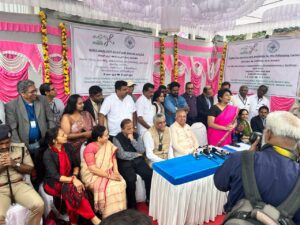
The event was held at the KR Pura metro station premises. (Supplied)
Fifteen years later, on October 11 2023, I witnessed a similar sentiment among the CEOs and CXOs of Bengaluru’s top IT companies who had gathered outside the newly-opened KR Pura Metro station, on a sultry Wednesday morning.
Only, this time, the adversity is called Bengaluru traffic.
Amid the whirring of large trucks, honking of vehicles and hurried strides of passersby, this group along with eminent IAS officers and IPS officials assembled at the entrance of the station for a cause that Bengaluru has waited for too long. The last-mile connectivity.
Karnataka Transport Minister Ramalinga Reddy and Prof Rajeev Gowda, ex MP, and the Vice Chairman of the State Institute for the Transformation of Karnataka and Brand Bengaluru inaugurated 35 feeder Bengaluru Metropolitan Transport Corporation (BMTC) Metro feeder service buses. These buses are expected to facilitate the connection to the new purple line section from KR Pura Metro station to ORR (Silkboard) and Whitefield that was thrown open to the public on October 9 2023.
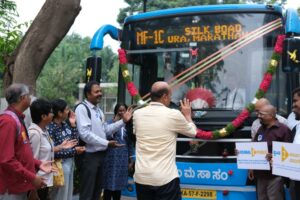
Feeder buses to connect newly opened Purple Line metro stations. (Supplied)
Making this dream of lakhs of Bengalureans come true is the team at #Personal2Public, which is an initiative to inspire the citizens to switch to public transport at least twice a week in order to reduce traffic congestion and pollution.
“Today, ORR is dream destination for many people who come here to work. We are now going to make their mobility better because of this partnership between DULT, BMRCL, BMTC, BBMP and BTP, auto unions and aggregators, civil society groups, research organisations and corporates,” shares Srinivas Alavalli, senior fellow at WRI India, who spearheaded this initiative.
Once known for its pleasant weather, large lakes, lush gardens, the IT hub of India — Bengaluru — seems to have earned the ill-repute of suffering the worst traffic nightmares. Case in point is September 27 2023 when a massive, unprecedented gridlock on Bengaluru city’s tech corridor, the Outer Ring Road (ORR), left Bengalureans fuming. Several motorists complained that they took about four hours to cover 15 km. Parents were worried as students, stuck in the bumper-to-bumper traffic, reached home late in the night. Traffic victims of this day might even live to tell this tale to their future generations.
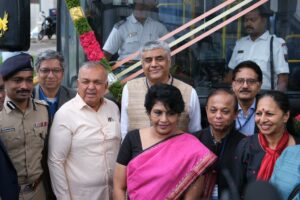
City planners, urban architects and environmentalists have been making a case for a sustained use of public transport. (Supplied)
To address this concern, Bengaluru’s city planners, urban architects and environmentalists have been tirelessly making a case for an increased and sustained use of public transport, which influences the urban road system in many ways.
The inauguration of the feeder buses is the beginning, says Manas Das, President of Outer Ring Road Companies Association (ORRCA).
“This is a 12-year-old organisation that has been working with 500 companies and 9,50,000 people on the Outer Ring Road. We met the Deputy CM of Karnataka, DK Shivakumar, recently, where we tabled all the issues. On the supply side, we are trying to solve road-related issues, frequency of transport, overall walkability, bus shelters etc. The demand side involves P2P adoption. If we don’t adopt, the government is going to question us. We are trying to balance both the sides. The idea is to show the government that there is a phenomenal number of people using it,” explains Das.
It’s a given that the CEO of any organisaton helps change happen by communicating its significance, modeling the desired changes, and getting personally involved. This is exactly what the campaign aims to achieve too, if you were wondering why CEOs and CXOs were part of the bus-ride activity. But given our cynical nature, the obvious next question is — will they actually use public transport?
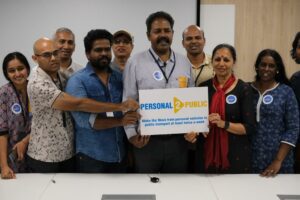
#Personal2Public initiative aims to inspire citizens to switch to public transport. (Supplied)
“CEOs taking this ride is symbolic. They don’t need to. It is the 95% of employees in any organisation that need to. For instance, I took the Metro today. So what’s the message I am taking forward? If 80-90% of a company takes public transport, that’s half the congestion battle won,” highlights Das.
However, Ravi Chandar, who works on city causes, and is a self- described patron saint of lost causes, disagrees. “CXOs and CEOs have to walk the talk. They must adopt public transport because if they do it, they will have the right to demand it from their employees,” he insists.
Rajeev Gowda calls this Personal to Public initiative a historic moment for Bengaluru. CEOs, he urges, will lead by example.
For Ram Narayanan, VP and MD of VMWare, who took the Metro from Nallurhalli to KR Pura Metro this morning, symbolism is the first step. The message of using public transport needs to spread within and beyond the organisation, he remarks. “As I was on the train, I put out a Linkedin post. By being part of this activity I am also sending a message to my peers in the industry to join me,” he tells South First.
Meanwhile, it was only earlier this year, in a report published by Time Out, where Mumbai ranked at number 19 on a list of cities with the world’s best public transport, thanks to its intricate local train network. In fact, it was the only Indian city on the list.
Perhaps what unites Mumbai and Bengaluru is that its people don’t have the luxury of time. Can Bengaluru then adopt a system similar to Mumbai?
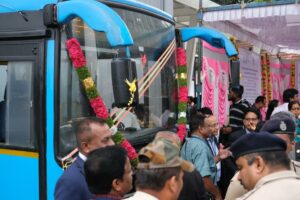
If there is connectivity, more people will travel in the Metro. (Supplied)
Comparison is not a good idea, says Das. Attributing to the difference in the scale and movement of traffic, he points out that competing with Mumbai’s model would be difficult.
Chandar concurs. Mumbai has twice the population of Bengaluru, but it has half the vehicular population of the latter.
“Bengaluru has four times more vehicular stress compared to Mumbai,” he adds.
But if this campaign becomes a role model, adoption will be easier, notes Das. “When someone sees that the Whitefield and ORR corridors are successful in doing it, the fever will spread. When corporates and white-collar working professionals spread the word, movements like this will become endemic,” he asserts.
Does this mean Bengaluru is ushering in a new era of creating a unique role model for sustainable use of public transport?
Narayanan believes it is. “For the first time, any of us living in Whitefield can take public transport to get anywhere. Buses always existed but it was not as convenient as finding your nearest Metro station, getting on it and reaching your destination,” he details, rushing to board the bus for its debut ride.
Packed with media professionals elbowing their way through to get bytes from the Transport Minister, CEOs and CXOs, we surely got a VIP ride to reach Intel’s Eco Space campus in Bellandur, in a record 26 minutes. Will this be a norm though or is it a purely one-day wonder given the stature of dignitaries riding on it?
“Earlier the population of the city was less. Now it is about 1.4 crore. So we have to take measures to improve the transport. Particularly where the Metro is running, connectivity is important. If the connectivity is there, more people will travel in the metro. That way, the congestion will come down,” Ramalinga Reddy, Transport Minister shares with South First while assuring that more buses will be launched this year.
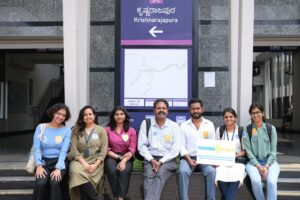
A pledge was taken by all participants to use public transport at least twice a week. (Supplied)
For Chandar, this is a long, overdue initiative. He is hopeful that the experience with the feeder buses along the KR Pura and ORR stretch will result in a similar demand for feeder buses along the entire Metro network. This, he says, is imperative in improving the ridership of the Metro and reducing the burden of private vehicles on the road.
“My fervent hope is that this will lead to a greater demand. Once you have market forces, bus manufacturers will launch smaller buses, which will be more economical for feeder buses,” he explains.
Speaking at the pledge ceremony at the Intel campus, Revathy Ashok, Managing Trustee and CEO of Bangalore Political Action Committee, requested the minister for 15,000 additional buses. “Today ,we are at 6,500 buses. We need 15,000 more. Our next project is the Inner Ring Road connecting Indira Nagar to Domlur to Koramangla. That is going to be another big one, exactly like the Outer Ring Road. So, let’s launch the next one,” she says, calling for support.
Chandar believes it’s all about a behavioural mind shift. Politicians, bureaucrats and CEOs can play a crucial role, he affirms.
For urban architect RK Misra it was heartening to see the initiative finally transpire. “The Whitefield Metro has been in the coming for so many years. I think the Metro and public transport are the only solutions to the city’s traffic woes. We have over 1.2 crore vehicles registered in the city for 1.4 crore people. At any given time, there are 30 lakh vehicles on the road. And we have only 1000 km of arterial, sub-arterial roads. Every kilometre has over 3000 vehicles on average, which is unsustainable. So unless we get on public transport, there won’t be a solution,” he emphasises.
Stressing the need for bus priority lanes, he adds, “When people see that the buses are going faster than other vehicles, and that they offer connectivity to the Metro, they will be more willing to take the Metro.”
Rajeev Gowda reminds the crowd that when they learned about this as part of the newly formed government, there was excitement. “We had promised in our manifesto that we would shift people to public transport. We have a grand ambition of making travel 75% on public transport and the first step was taken today,” he assures, urging everyone to join him in taking the pledge to support and use public transport.
The public-private partnership seems to be a viable model. Because as cities evolve, so must transit. And we are sure that Bengaluru remains hopeful of these baby steps to a million miles — or in this case, the last mile!

Jul 26, 2024

Jul 21, 2024

Jul 20, 2024

Jul 20, 2024

Jul 19, 2024

Jul 18, 2024